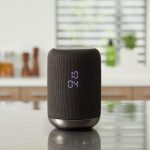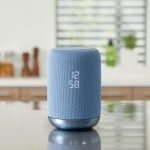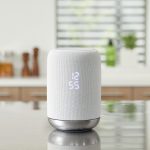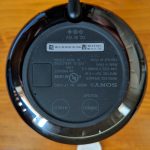
When Google announced the expansion of their Assistant to third-party speakers, the Sony LF-S50G drew a fair amount of attention for it’s stylish look, built-in clock and potentially great sound.
The speaker went on-sale in Australia late last year for $249 in three colour options: Black, Blue and White. The speaker is on-sale through a number of retailers as well as through Sony themselves who are selling it on their website.
I’ve been a big fan of Google Home and the more recently released Google Home Mini, but wanted to see if there was a reason to up the ante and invest in a name brand speaker. I’ve already checked out the TicHome Mini, so we know Google Assistant works quite well on them, but it’s time to see what Sony can do.
I’ve been checking out the LF-S50G for the past two weeks, and I have some thoughts.
What’s in the Box
If you’re expecting more than a speaker and a power supply in the box you’re going to be pretty disappointed, that is unless you like paperwork.
The speaker is quite well protected in the box with foam inserts making sure it can ship without damaging the hardware. The foam insert has a small nub in the base which fits into the power socket in the speaker to ensure it’s sitting the right way.

When go to you open it, the box simply slides up to reveal the speaker and underneath the bottom foam packaging is the power brick and a bunch of paperwork that includes warranty information and of course a quick start guide. Take the speaker out, plug it in and then it’s over to setting it up.
Setup
If you’ve ever set up a Google Home (or Mini) speaker you’ll be familiar with this process. You’ll need the Google Home app (available free in Google Play or the Apple app store) and once it’s installed the app will note the presence of a new speaker in the vicinity and prompt you with a card to set it up.
Setup is relatively painless, it uses a Wi-Fi direct connection to connect the speaker to your network, and once it’s connected you simply name it (usually with the location you’ve put the speaker in) and it then completes a check for any firmware updates, matches any voice print you’ve assigned previously and you’re done.
The Hardware
The Sony speaker design is quite stylish, it’s obviously a cylinder and contains a monaural type speaker which includes a 48mm satellite speaker and 2.09″ Sub Woofer. This setup, says Sony, gives a 360° room-filling sound which is pretty accurate, but we’ll get to that later.
You can get a closer look at the speaker setup by removing the grille, or if you want to you can clean that grille by twisting it – replacing it is just as simple.

Hardware wise, the speaker ahs Bluetooth (v4.2) with NFC tap to pair target on the back of the speaker, dual-band Wi-Fi and being a Google Assistant-powered device, the speaker is a Chromecast target so you can cast from compatible apps to it.

While the cylinder has no real front or back there are LED lights built-in to the speaker behind the speaker grill which wraps around the entire unit. The LEDs make up a clock, and there are four LEDs above that which indicate when Google Assistant is listening. Those LEDs also change to indicate the percentage of volume, and an LED strip runs around the top of the speaker – again, you can get a closer look at this when you take the grille off.

There’s no way to set the clock or alarms on the speaker, but there are buttons on the speaker and a touch sensitive panel on the top. The touch sensitive panel lets you control your music (play/pause) and volume, while a dimmer button on the base allows you to control three levels of brightness of the LEDs as well as turning them off — full bright is too bright to sleep with FYI. There’s also a lock button next to that which stops input from the touch panel and buttons for three minutes.
The last real ‘feature’ of the LF-S50G is that it has an IPX3 rating. While the X indicates no dust rating, the 3 gives you very limited splash protection. That splash protection isn’t a sign you should take it to the pool, but rather it can be sprayed and keep on kicking – it’s technically tested with a spray nozzle, so it’s worthwhile being careful.
Sound Quality
Playback
If you’ve listened to the Google Home speaker you’ll note that it’s an okay speaker, but it’s not high-end. The Sony LF-S50G is better, but not by much. At first play you’ll actually be pretty impressed with the sound on the LF-S50G, but give it some time and you’ll start to hear some imperfections.
While it’s got plenty of mid-range sound it’s lacking in bass, there’s just not much depth to the sound, and with a mere 2″ Sub it’s understandable. It is essentially built as a clock radio, but it’s priced at the high end of that market at $249 RRP.
One thing it can do is amp up the sound so there’s plenty of volume, but it does peak out when it does so you probably notice any imperfections faster.
The big saviour for the speaker is that you can simply insert it into multi-room Audio using Chromecast and it simply slots into a whole home audio setup quite neatly.
Microphones
The far-field microphones built into the speaker work quite well picking up your voice easily though it wasn’t a huge test for the most part when you’re addressing it while laying in bed. Acknowledging this I moved the speaker into the kitchen, but found it performed well here too.
There are occasions when you’re playing music or ambient noise is up that you may have to address Google a second time to ensure it picks up your voice but it’s pretty good for the most part.
Should I get one?
I like Sony gear, but I’m not 100% convinced that this is the best Google Assistant speaker for your dollars – especially your nearly $250. The good news is if you shop around you can get the LF-S50G for under $200 making it a lot more practical, but then again if you can get a Google Home for $128 on special as it was prior to Christmas here in Australia you’d be in a better position.
It is a very capable alarm clock – but then again, so is a Google Home or Home Mini, though you definitely get better sound quality from the Sony.
The built-in LED speakers are the big drawcard for me, it makes the speaker a little more useful and practical overall than just a Chromecast target, or Google Assistant powered speaker like Google Home. The design is a little more ‘Sony’ as well, so it looks pretty rather than like an air-freshener or fabric puck sitting on your bench.
It really comes down to how much you want to spend on a Google Assistant speaker and if that built-in clock makes it worthwhile for you. I’ve got some misgivings, but that said I’m buying one. I’ve had the same traditional digital alarm clock sitting beside my bed for the last 15 years and it’s time to upgrade. I think this one will give me a full 15 years before I update next time.










Thanks for the review Dan. I’m waiting for Sonos to add Google Assistant to the Sonos One then I’ll purchase it for regular music listening.
“There’s no way to set the clock or alarms on the speaker, but there are buttons on the speaker and a touch sensitive panel on the top.” Can you clarify how you actually set the time / alarms then? Is it native from Google Home App, or do I need a specific sony app that will stop being supported in 2 years time when I have android 9 or 10 on my phone. This is the only thing that makes me hesitant about app powered devices. I have been burned too many times when the app support dies off if… Read more »
You set alarms with voice instructions the same as a google home. There isnt a special app – its the same Google Home app you use for setting up Google Homes and Chromecasts.
Its a pretty shit clock, as I see it – the LEDs at the lowest setting light up the room at night and cant be seen during the day. There is no automatic dimming.
As per Luke’s answer below the time is set from the Google Home app on your phone, basically it syncs up. You simply talk to your speaker and use the Google Assistant to set alarms.
An ambient light sensor to set the intensity of the LED lights for the clock would be a good improvement for gen 2.
Google Home has been going great guns, so I don’t see it going away in the next few years. I think it will be quite widely available for some time to come.
You can buy it quite a bit cheaper from CostCo